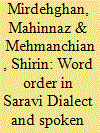| Srl | Item |
| 1 |
ID:
151453


|
|
|
|
|
| Summary/Abstract |
The dative case in Vafsi appears in three structures: (a) the case of the experiencer in sensory verbs, (b) the case of the indirect object (IO), and (c) the case of the object of the preposition /da/ (to), or the preposition /az/ (to), or the enclitic /-o/ (to), or the object of the postposition /rā/ (for). In Vafsi, as in many other Indo-European languages, sensory verbs necessitate the emergence of quirky subjects which have the experiencer function and are dative case marked. In order to analyze the dative case marking in Vafsi using optimality theory, this article uses the faithfulness constraint of faith-lex and the markedness constraint hierarchy of *ERG>>*DAT>>*ACC>>*NOM. Vafsi always allocates the dative case to the IO of the ditransitive verbs. This phenomenon is illustrated by use of an optimality theory (OT) tableau. Some Vafsi ditransitive verbs dative case mark the IOs using adpositions. If so, Vafsi differential adpositional case marking (DACM) will rule, as the IOs are objects of adposition (OAs) simultaneously.
|
|
|
|
|
|
|
|
|
|
|
|
|
|
|
|
| 2 |
ID:
098435


|
|
|
|
|
| Publication |
2010.
|
| Summary/Abstract |
This study aims to analyze the positions and syntactic functions of dependent and independent personal pronouns in the Kakavandi Laki dialect in the region of Harsin (Kermanshah/Iran), an endangered dialect of Persian. The paper provides a morpho-syntactic description and investigates the dialectal characteristic positions of the pronominals in regard to their syntactic functions, which illustrate noticeable differences in comparison to Persian. The main functions under investigation include: subjective, objective, oblique and possessives, on the basis of which the pronominal positional variety is classified in the dialect. The study further examines the dialectal agreement patterns which demonstrate both ergative and non-ergative features.
|
|
|
|
|
|
|
|
|
|
|
|
|
|
|
|
| 3 |
ID:
111191


|
|
|
|
|
| Publication |
2012.
|
| Summary/Abstract |
This research is a comparative study of the typological parameters of contemporary spoken Persian language and Saravi, a main dialect of the Mazandarani language, using some Greenbergian universals as its theoretical framework in word order correlations. The study aims to determine the common parameters and the variations of specific syntactic constituents among the systems studied here. On this basis it investigates the unmarked word order in declarations, as well as preparing a systematic comparison of phrasal genitive and adjective structures in the systems under investigation, along with examining their self and possessive pronominal orders. Together with revealing the use of differential orderings within the systems in these respects throughout the paper, the findings uphold Greenberg's language universals as a useful tool in classifying language types as well as specifying the variations of the syntactic constituents.
|
|
|
|
|
|
|
|
|
|
|
|
|
|
|
|